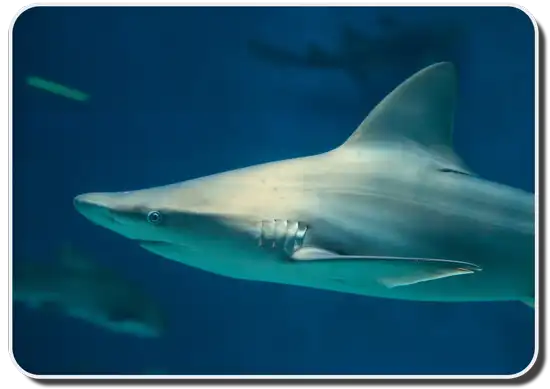Sandbar sharks are a species of requiem shark found in the Atlantic and Pacific Oceans. It has several other names, such as brown shark and thick skin shark, and is often confused for the sand tiger shark, which is an entirely separate species despite the two having similar sounding names.

Sandbar Shark Scientific Classification |
|
| Kingdom | Animalia |
| Phylum | Chordata |
| Class | Chondrichthyes |
| Order | Carcharhiniformes |
| Family | Carcharhinidae |
| Genus | Carcharhinus |
| Scientific Name | C. plumbeus |
Description
Sandbar males are 5.9 ft long, while females are a bit longer at 6.6–8.2 ft. On average, these sharks weigh 100 to 200 lbs. The largest sandbar specimen on record is 8 ft long and 260 lbs.
 Its first dorsal fin is tall and triangular, while its second dorsal fin and anal fin are similar in size and much smaller. The pectoral fins of this shark are very long. Their bodies are heavy-set, with rounded snouts shorter than the average shark. Its upper jaw consists of teeth with broadly uneven cusps and sharp edges, while teeth on the lower jaw have serrated edges.
Its first dorsal fin is tall and triangular, while its second dorsal fin and anal fin are similar in size and much smaller. The pectoral fins of this shark are very long. Their bodies are heavy-set, with rounded snouts shorter than the average shark. Its upper jaw consists of teeth with broadly uneven cusps and sharp edges, while teeth on the lower jaw have serrated edges.
Like several other shark species, the sandbar shark displays counter-shading, with a dorsal region that is brownish or dark gray and a white belly.
Where do they live
Map Of The Sandbar Shark’s Habitat

As the name indicates, the sandbar shark lives in shallow areas like bays, estuaries, and harbors, close to the sandy and muddy bottoms. However, they have also been spotted in deeper waters and intertidal zones. Juvenile sharks live in nursery grounds in the lower Chesapeake Bay, Delaware Bay, and South Carolina, with smaller nurseries in Boncuk Bay in Marmaris, the Florida Keys, and Muğla/Turkey.
They are found globally in both temperate and tropical waters. Their range includes the Western and Eastern Atlantic, the Mediterranean, and the Indo-Pacific, from the Hawaiian Islands, the Persian Gulf, the Red Sea to South and East Africa. The shark has also been spotted in the Galapagos and Revillagigedo islands in the Eastern Pacific.
Behavior
Dietary
The sandbar shark feeds on rays, fish, and crustaceans. Juveniles feed on blue crabs in the Chesapeake Bay.
Predatory
It is an opportunistic feeder, making a meal out of anything it spots on the ocean floor.
Social
While the juveniles live in mixed schools, the adult males move about in same-sex schools once they mature. Females are more likely to be solitary and move almost alone. Both sexes only interact when they want to mate.

Migratory
As a highly migratory species, these sharks swim south in the winter and head north again when it is warmer. The males will migrate earlier than the females.
Reproductive
They are viviparous, with mothers giving live birth after bearing their pups for 1 year. Females go through biennial and triennial reproductive cycles and start ovulating in the summer. Each litter has around 8 pups.
It takes 12 years for males to reach sexual maturity, while females do so at 13. On average, the sandbar shark lives for 35-41 years.
Adaptations
Like other sharks, the sandbar possesses heightened senses, notably sight and smell, and can detect vibrations in the water and electrical fields generated by other animals.
Interactions with humans
While large and intimidating due to a similar appearance to the bull shark, sandbar sharks generally avoid humans and are not dangerous. Despite these sharks not usually attacking humans, in August 2021, a 12-year-old girl was bitten by one of these sharks in the leg, though she survived with 42 stitches.
The IUCN lists the sandbar shark as “Endangered” or “EN”, and the New Zealand Department of Conservation classified it as “Data Deficient” under its Threat Classification System.
